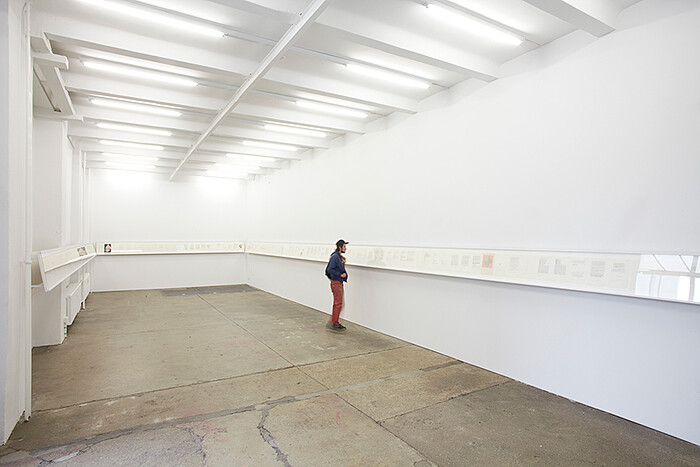The traditional form of the novel, as we know it since the nineteenth century, seems oddly impervious to change. In comparison to the extraordinary evolutions undergone by art, very little has changed between today’s mainstream fiction and its Balzac, Austen, and James equivalents. Most of the novel’s purported evolutions have either proven to be barren (as Julio Cortázar’s 1963 Rayuela, a masterpiece which left in its wake a string of choose-your-own-ending fictions) or resorted to the more or less forceful insertions from other disciplines: pictures, traditionally, or sound and video in their most recent tablet incarnations. A text-based fiction, it would seem, has few places to go except where it already is.
This state of affairs is both questioned and affirmed by the work of the late Henri Chopin, whose, well, novel, La crevette amoureuse [The loving shrimp], (1967/1975)—is on show in Berlin at Supportico Lopez. Throughout most of the twentieth century Chopin has been a prominent experimental poet and performer (born in Paris in 1922, he remained productive until 2008, the year he died); one of the first and most prolific practitioners of concrete and sound poetry, Chopin was also a publisher of journals such as Cinquième Saison (1959–1963) and Revue OU (1964–1974). The trilogy collectively titled Le dernier roman du monde [The last novel in the world] was begun in 1961 and never fully published: its first, eponymous installment appeared in a limited edition in French in 1971, while its other two parts have only been circulated privately by collector Peppe Morra. Of that novel, La crevette amoureuse is the third and final section. The exhibition showed 145 of its 146 typewritten pages, displayed in tilted vitrines that tried as much as possible to avoid all fetishizing effect and actually facilitate reading while standing.
The book is a philosophical parable, consisting of several dialogues between ERnest and MARiette, usually taking place before or after sex. He is characterized as a “head of state” or “head of the world,” and peppers his pillow talk with political concerns, the arbitrary laws and decrees of his own domain; his solipsism and arrogance are sometimes spurred on, sometimes discouraged by MARiette. As the book progresses, ERnest’s philosophical boutades appear to be a satire of the intellectualized epistemology of the Descartes-Berkeley-Hume-Kant-Fichte lineage. The text is in fact explicitly dedicated to Kant, whose self-centered brand of skepticism finds an extreme echo in ERnest’s absolutism as a ruler. Increasingly frustrated by the exercise of a power as absolute as it is vacuous (for his theories prevent him from acknowledging the existence of other subjects—both in the philosophical and in the political sense), ERnest ultimately resolves to forsake his name and, thereby, his subjectivity.
This summary, however, does little justice to La crevette amoureuse, which is visual as much as it is textual. Interspersed in its typewritten pages are both abstract and figurative compositions of symbols, reminiscent of Futurist poetry and of typographic art. Even though sometimes illustrative (the book includes portraits of its main characters, as well as geometric patterns), these compositions hardly qualify as illustrations as such, since in a way they are the text itself—they are literally made of the same stuff. The two “forms” flow into each other with no clear way of separating narration and image; at times Chopin explicitly challenges the meaningfulness of such distinctions, as when he presents a triangular sequence of punctuation marks as the text of one of ERnest’s last decrees.
This is in line with Chopin’s writing style, reminiscent of the French tradition of circling around or brushing against the absurd (from Jarry to Tzara and Ionesco). Dialogues in La crevette amoureuse often start out as realistic, then veer towards the surreal (through exponential chains of puns and word-play), only to ultimately graze across the downright nonsensical. The step from this to the altogether visual, non-linguistic use of symbols appears to be quite small: sentences gradually lose meaning, then words, then letters. (“All this beauty means nothing at all,” announces one such page.) Someone not versed in the history of philosophy might not be able to distinguish between the Dadaist impromptus and quotations from Kant; someone without more than a passing knowledge of French would likely be unable to discriminate words from puns. Quite similarly, a being unfamiliar with the way human languages are written (such as an alien life form, or, for that matter, a cat) would see no distinction between what we consider “text” and “illustration.”
Chopin’s dactylopoèmes thus appear to be more than witty abstract compositions, or mere (if beautifully crafted) instances of typographic art: in this novel they are legitimate parts of a text. They are not appropriations or “misuses” of linguistic means to serve a pictorial end: they are extreme instances of their proper use—evolutions, if you like.
There might be something to be said about such a significant and innovative work of literature finding its place in a gallery exhibition instead of a literary context (Chopin’s work has also recently been shown, among others, at the MoMA in New York). Such a place was undoubtedly sanctioned and sought out by the writer himself: each sheet of the manuscript is visibly, and quite uncannily, signed signaling something closer to a page’s own independence rather than its interconnectedness with other pages in a novel. This, on the one hand, bespeaks the fact that, “Almost nowhere else does the pure textuality of the text show itself so clearly as in art” (to paraphrase a point Boris Groys originally made about art criticism); but also that, after the disappearance of what had once been their elective publics, radical innovators from all disciplines are increasingly seeking both shelter and an audience within the art system, seen as a sort of refugee camp for experimental practices. Yes, there might be something to be said about this—and it wouldn’t necessarily be optimistic. And yet for the last novel of the world, a refugee camp might be a suitable home, after all.







